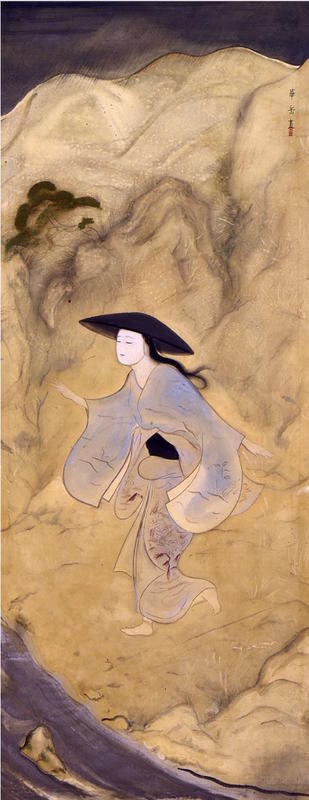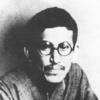More about Kiyohime at the Hidaka River

Contributor
This work starts with a story:
Once upon a time there was a monk named Anchin who was traveling back to his home village when he decided to stop and rest along the Hidaka River. He decided to stop and rest at a wealthy landlord’s house where he ended up meeting the landlord’s daughter, Kiyohime. The two fell in love and Anchin promised that he would come back some day to marry Kiyohime.
By the time he got back to his village and temple, though, Anchin completely forgot about Kiyohime and his promise to return to her, so he never came back. Whoops. It probably goes without saying, but Kiyohime was really angry about being stood up, as anyone would be. Getting stood up in Japanese folklore comes with some pretty serious repercussions, so instead of drowning her feelings in a pint of Ben and Jerry’s, Kiyohime crossed the Hidaka River and turned into a snake.
After her transfiguration Kiyohime tracked down Anchin who, screaming in fear when he saw his ex-girlfriend in snake form, ran and hid in the temple bell. His hiding spot didn’t keep him safe for long because Kiyohime found him right away and wrapped herself around the bell, setting herself, the bell, and Anchin on fire with her rage. They fused with the bell and from that day forward the bell rang with the sound of Anchin and Kiyohime screaming and wailing in sorrow. That is, until the monks prayed the ghosts away.
Now, what’s the point of all this, you might ask? Well, I’ll tell you. The work and the extra special traditional message were both reactions to the Dada movement. The Dada movement draws out strong reactions in all of us, but Japan’s was to run as far as possible from everything Dada. Μurakami Kagaku painted this work as a part of the “Society for the Creation of a National Style of Painting”, or Kokuga Sosuku-Kyōkai of which he was a founding father, in order to set parameters and avoid seeing the rise of Dada in Japan. These parameters were also inspired by works like Harada Naojiro’s Kannon Bodhisattva Riding the Dragon, which was also a smidge radical at its debut.
Later, though, Murakami Kaguku became more of a free spirit and fought against the Kanten, also known as the Japanese version of the French Academy. Murakami once called the act of creating art “praying in one’s inner room”. His inner room was full of Japan’s history, but any fan of Japanese art can thank their stars that he realized that everyone’s inner room is different and beautiful.
Sources
- Amy Friedman and Meredith Johnson, "The Learning of Love (A Japanese Folktale), Tell Me a Story," Uexpress, June 4, 2017, , accessed June 14, 2017, http://www.uexpress.com/tell-me-a-story/2017/6/4/the-learning-of-love-a….
- "The 1st Collection Gallery Exhibition 2013-2014 | The National Museum of Modern Art, Kyoto," The National Museum of Modern Art, Kyoto, 2013, , accessed June 21, 2017, http://www.momak.go.jp/English/collectionGalleryArchive/2013/collect
- "Murakami Kagaku," SHIBUNKAKU, 2016, , accessed June 21, 2017, https://www.shibunkaku.co.jp/english/art/murakami_kagaku/.











